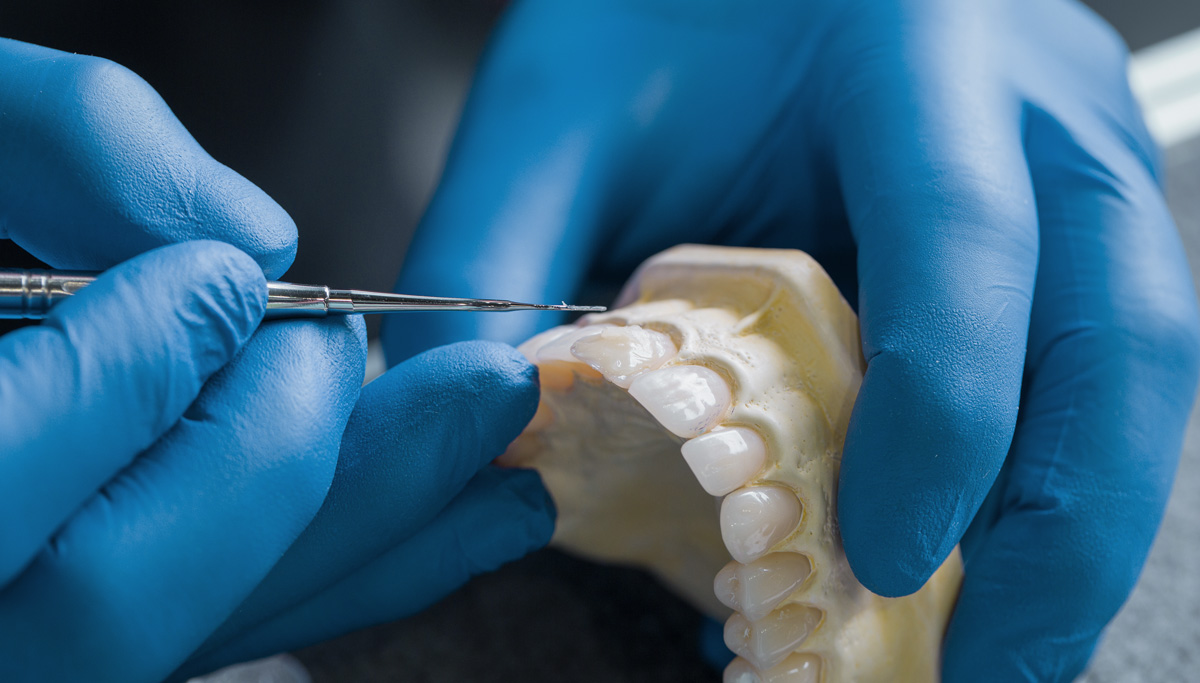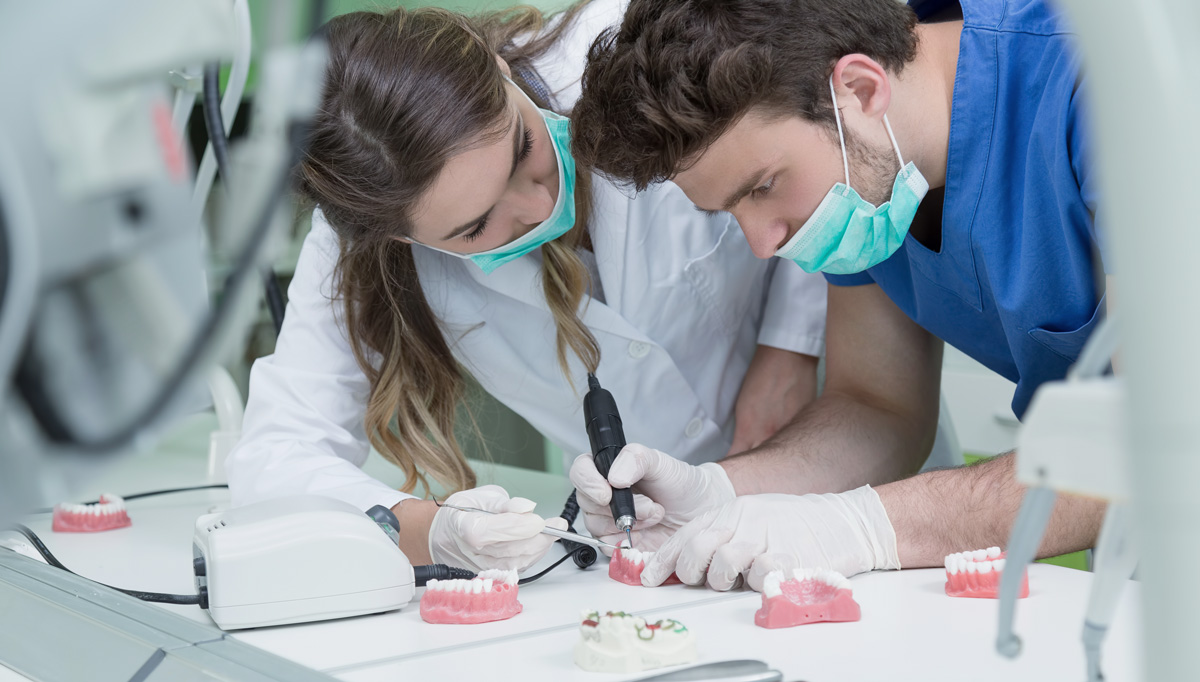Dental lab fee transparency is an increasingly important topic for dental practices that want to foster trust with their patients while maintaining operational efficiency. Patients today are more informed and proactive about their dental care, which makes clear communication about fees a key part of delivering high patient satisfaction.
Whether a practice is providing routine check-ups, cosmetic dentistry, or complex procedures such as dental implants, understanding and explaining the true cost of treatment is crucial. This includes lab expenses, material costs, and other fees that contribute to the overall cost structure of care.
By discussing dental lab pricing openly, dentists can help patients make informed decisions and avoid unexpected costs, ensuring a higher level of patient care.
Understanding dental lab fees
What are dental lab fees?
Dental lab fees are the charges a dental practice incurs when outsourcing work to a dental lab. This can include creating crowns, bridges, dentures, or components for cosmetic dentistry solutions like dental implants.
Lab fees cover the services provided by lab technicians and skilled technicians who use cutting-edge technology and digital workflows to ensure high-quality outcomes.
How they differ from clinical costs
Lab fees differ from clinical costs, which include dentist time, clinical outcomes, patient examination, and in-office procedures. While clinical costs relate to the direct interaction between patient and dentist, lab expenses are an external factor that can vary depending on the dental lab partner chosen, the complexity of the case, and material costs.
Understanding the true cost of lab services allows dentists to make better financial management decisions for their practice and offer patients clear and transparent pricing.
The current state of fee transparency
Typical practices in UK dental clinics
In many UK dental practices, lab fees are included within a treatment plan without detailed breakdowns. Some clinics provide patients with a single total cost, while others offer an itemised approach that highlights lab fees, materials, and other expenses.
Practices that adopt transparent pricing tend to see higher patient satisfaction and fewer disputes regarding charges. Patients who are informed about lab expenses are better able to budget and make informed decisions about treatment.
Industry standards and common approaches
Industry standards encourage clear communication about the total cost of treatment. Practices that adopt an open communication strategy regarding lab pricing and operational efficiency set themselves apart.
The key factors for successful implementation include proper budget allocation, cost management, and strategic planning to achieve cost optimisation and cost reduction. Transparent pricing also supports better understanding between the dentist and the patient, ensuring high patient satisfaction and improving patient care outcomes.
Reasons to share lab fees with patients
Promoting trust and transparency
Sharing lab fees fosters trust between the dentist and the patient. Patients are more likely to feel confident in their treatment plan when they have a better understanding of how costs are determined and what they cover.
Transparent pricing and clear communication can prevent hidden fees and provide accurate budgeting for treatment, enhancing patient care. Open communication regarding lab expenses, such as those for crowns or dental implants, demonstrates that the practice values patient safety and quality standards.
Helping patients make informed decisions
By including dental laboratory fees in discussions, dentists give patients the ability to make informed decisions about their dental care.
When they understand the elements that make up the cost of procedures, patients are able to compare effectively and decide on the best course of action for their needs. This level of openness contributes to high patient satisfaction and improved clinical outcomes.
When patients understand the cost structure, including lab pricing, material costs, and service quality, they are more likely to adhere to treatment plans and engage in long-term dental care.
Arguments against sharing lab fees
Risk of patient confusion
Some dental practices are concerned that detailing lab expenses may confuse patients. Lab pricing can vary depending on lab capabilities, material costs, and service quality, which may make the total cost appear inconsistent across treatments.
Dentists must ensure that explanations are clear and concise to prevent misunderstandings. Patients may struggle to interpret differences between lower costs from one lab and higher costs from another without guidance.
Potential impact on perceived value
Revealing lower costs from lab partners might cause patients to question the overall quality of treatment. Conversely, higher costs may raise concerns about affordability.
Practices need to balance open communication with reassurance about quality standards and the performance metrics of their lab partners. Explaining the key role of lab technicians and skilled technicians when it comes to achieving the very best clinical outcomes can justify lab expenses and support cost efficiency.

Legal and ethical considerations
Compliance with private practice regulations
Dental practices must comply with regulations governing cost transparency. Accurate disclosure of lab fees, material costs, and total cost ensures that the practice adheres to ethical standards and avoids any risk of misleading patients.
This transparency also aligns with professional guidance that emphasises patient safety and informed consent. A clear pricing structure helps practices demonstrate financial stability and operational efficiency while avoiding hidden fees.
Ethical responsibilities to patients
Ethical considerations require dentists to fully disclose the costs associated with any recommended treatment.
Patients have a right to know things like lab pricing and the services included for a particular treatment. This ensures patients can make decisions that balance quality, patient care, and budget considerations.
Transparent pricing also helps the practice when it comes to accurate budgeting and strategic planning, as knowing exactly how much patients have agreed to pay allows for better allocation of resources and cost savings.
Impact on patient communication
How fee discussions affect patient relationships
Discussing lab fees openly and honestly improves patient relationships. Patients want to know the costs and the rationale behind pricing structures as, for many, dental treatment is a significant financial investment.
Clear communication about lab expenses, clinical outcomes, and total cost builds trust and fosters high patient satisfaction. Open communication helps patients avoid unexpected costs and allows them to understand the total cost of their dental care, which can improve long-term patient retention.
Strategies for clear and professional explanations
To communicate effectively, dentists can provide itemised treatment plans, highlight lab capabilities, and explain how lab expenses contribute to the overall quality of procedures.
Using visual aids or breakdowns during patient examinations or new patient examinations can help patients understand complex pricing models and avoid unexpected costs. Clear communication about lab expenses and material costs can also reinforce the value of choosing the right dental lab partner.
Practical approaches to sharing fees
Including lab costs in treatment plans
A practical method is to include lab fees within the treatment plan while outlining each component separately. Patients can see the cost of materials, lab technicians’ work, and the dentist’s services.
This approach allows patients to make informed decisions and prevents disputes over fees. A detailed treatment plan also supports accurate budgeting, cost management, and overall financial stability for the practice.
Providing itemised quotes without overwhelming the patient
Dentists can provide a detailed breakdown of lab expenses while still focusing on patient care. Presenting lab pricing alongside clinical procedures, digital workflows, and expected outcomes ensures patients understand the value provided without being overwhelmed by complex cost structures.
Clearly laid out quotes encourage better understanding of cost efficiency, operational efficiency, and strategic planning while helping to maintain patient safety and high patient satisfaction.
Financial implications for the practice
Effect on practice revenue and profitability
Transparency regarding lab fees can influence financial management within a dental practice. Understanding the true cost of lab services, material costs, and the pricing model allows dentists to allocate budget effectively and achieve cost efficiency.
Operational efficiency, cost optimisation, and cost reduction strategies can contribute to better overall financial stability. Awareness of lab expenses also supports budget allocation, allowing the practice to plan for lower costs without compromising service quality.
Balancing transparency with sustainable pricing
Practices must balance transparent pricing with sustainable pricing to remain competitive. Open communication about lab fees, service quality, and lab capabilities helps justify charges.
Strategic planning and cost management ensure that lower prices or cost savings do not compromise patient care, clinical outcomes, or quality standards. A sustainable pricing model promotes long-term financial stability and reinforces trust with patients.
Helping patients manage treatment costs
Payment plans and financing options
To improve accessibility, dental practices can offer payment plans or financing options that spread the total cost of treatment over time. This allows patients to undergo necessary procedures such as crowns or dental implants without the burden of higher costs upfront.
Payment plans also support patient care by ensuring adherence to treatment plans and improving patient satisfaction.
Offering guidance on insurance and third-party coverage
Dentists can help patients understand how insurance, third-party coverage, or other reimbursement options impact lab fees and total costs. Patients who are guided in navigating their coverage are less likely to encounter unexpected costs.
Transparent pricing and clear communication about lab expenses, material costs, and total cost contribute to accurate budgeting and overall financial management.
Tools and resources for dentists
Software and templates for fee breakdowns
Digital workflows and software can simplify lab pricing disclosure. Practices can use templates to create itemised treatment plans that detail lab expenses, material costs, and dentist fees.
These tools improve operational efficiency, cost management, and allow patients to make informed decisions with a better understanding of the true cost of dental care.
Continuing professional development and guidance documents
Dentists should remain informed about new developments in lab technology, skilled technicians, and cost optimisation strategies.
Continuing professional development ensures that practices maintain quality standards, achieve high patient satisfaction, and stay competitive in providing cost-efficient, safe, and effective dental care.
Guidance documents and industry performance metrics help practices select the best dental lab partner and optimise overall budget allocation.
GoDigital Dental lab: quality restorations that are well worth it!
At GoDigital Dental Lab, we understand that dental lab fee transparency is not just about sharing numbers: it’s about building trust and empowering patients to make informed decisions.
A leading digital dental laboratory, we are dedicated to providing high-quality restorations that combine the best of today’s cutting-edge technology with expert craftsmanship. Our clear pricing model ensures that everyone can confidently navigate the cost of treatment with knowledge of exactly what has gone into creating a beautiful new smile.
Our technicians use advanced digital workflows to create custom restorations for each patient’s specific needs. Whether it is dental implants, crowns, bridges, or cosmetic dentistry, we focus on accuracy, reliability, and appearance. With GoDigital Dental by your side, you get a trusted dental lab partner dedicated to delivering excellent results that improve patient satisfaction and support the financial stability of your practice.
FAQs
Are lab fees usually included in the patient’s overall treatment cost or billed separately?
In many dental practices, lab fees are included in the total cost of treatment, so patients receive one overall price for procedures such as crowns, bridges, or dental implants. This makes it easier to understand the total cost and avoid unexpected costs. Some practices provide an itemised breakdown, showing lab fees separately, along with material costs and dentist fees.
Whether included or listed separately, clear communication is important. Explaining lab expenses helps patients make informed decisions, understand the true cost of treatment, and ensures high patient satisfaction while supporting transparent pricing and budget planning.
Can using digital dental labs reduce lab fees?
Using a digital dental lab can often help reduce lab fees. Digital workflows, such as 3D scanning and computer-aided design, allow lab technicians to work more efficiently, which can lower material costs and shorten production time. This improved operational efficiency can result in lower prices for dental practices and their patients while maintaining high standards. Digital labs also reduce errors, helping avoid extra costs from remakes.
Choosing the right dental lab partner with skilled technicians and cutting-edge technology can improve patient care, ensure accurate budgeting, and support cost efficiency without compromising the quality of restorations.
Do lab fees affect the total cost of treatments like veneers?
Yes, lab fees play an important role in the total cost of treatments such as veneers. When a dentist works with a dental lab, skilled technicians use high-quality materials and advanced technology to design and create the veneers. These lab expenses are included in the treatment cost and can vary depending on the lab’s pricing structure, material costs, and service quality.
While lab fees may increase the overall budget, they ensure reliable results, natural appearance, and long-lasting restorations. Clear communication about these costs helps patients make informed decisions, avoid unexpected costs, and understand the true value of their treatment.
Can dental lab fees be negotiated or reduced?
In some cases, dental lab fees can be reduced or managed, but this often depends on the agreement between the dental practice and the dental lab partner. Larger practices or those that place regular orders may be able to negotiate lower prices or benefit from cost savings through bulk work. Practices can also lower costs by choosing materials carefully, improving digital workflows, and working with skilled technicians who deliver accurate results the first time.
While fees may vary depending on the lab’s pricing model and service quality, clear communication and good financial management can support cost efficiency and avoid unexpected costs.
Do higher dental lab fees mean better quality?
Higher dental lab fees do not always mean better quality. Lab pricing can vary depending on materials, technology, and the lab’s cost structure. Some labs may charge higher costs because they use premium materials or advanced digital workflows, while others keep lower prices through cost efficiency and careful cost management.
The key factors that truly affect service quality are the skills of the technicians, the lab’s capabilities, and its quality standards. Patients should not assume that higher costs always equal better results. Working with the right dental lab partner ensures reliable restorations, safe procedures, and high patient satisfaction.
How much communication is there between the dentist and the dental lab?
Good communication between the dentist and the dental lab is very important. The dentist provides the lab with details from the patient examination, X-rays, impressions, and treatment plan. Lab technicians then use this information to create crowns, veneers, dentures, or dental implants that fit well and look natural. Clear communication helps avoid unexpected costs, supports accurate budgeting, and ensures patient safety.
Many modern labs use digital workflows, which allow quick updates and adjustments if needed. When the dentist and the lab work closely together, the results are better for patients, leading to high patient satisfaction and reliable clinical outcomes.
In what ways can a dental practice ensure transparency and quality control when working with a dental lab?
A dental practice can ensure transparency and quality control by choosing the right dental lab partner and keeping open communication. Clear pricing structures with no hidden fees help patients understand the true cost of treatment and avoid unexpected costs. Regular reviews of performance metrics, material costs, and lab expenses allow accurate budgeting and cost efficiency.
Dentists can also ask about the lab’s quality standards, digital workflows, and the skills of its technicians. Working with a lab that uses cutting-edge technology and follows strict quality checks ensures reliable results, safe procedures, and high patient satisfaction across all treatments.
Is there a difference in quality or cost between UK-based labs and labs overseas?
Yes, there can be differences in both quality and cost. Overseas labs may offer lower prices due to lower material costs or labour expenses, which can help reduce lab fees. However, these savings may come with longer delivery times and less direct communication between the dentist and the lab.
UK-based labs often provide faster turnaround, easier open communication, and stronger quality standards, which support patient safety and high patient satisfaction. The true cost of treatment depends on more than lab pricing alone. Practices should consider service quality, lab capabilities, and reliable clinical outcomes when deciding which dental lab partner to use.
How do I choose a dental lab based on more than just price?
When choosing a dental lab, it helps to look at factors that show long-term value, not just the lowest fee. Ask whether the lab offers support with treatment planning, provides training for dentists, or shares updates on new techniques. Consider how well the lab handles complex procedures such as cosmetic dentistry or dental implants, since not all labs have the same experience.
It is also useful to check if the lab invests in research and new equipment, as this shows commitment to future quality. By reviewing these points, you can select a partner that supports both care and progress.
What can we do as a dental practice to potentially reduce lab fees?
Dental practices can lower lab fees by improving in-house processes before work is sent to the lab. Careful patient examinations, accurate impressions, and clear X-rays reduce the chance of remakes, which helps avoid unexpected costs. Using digital scans instead of traditional moulds can also save time and lower expenses by giving technicians precise information.
Good record keeping and well-structured treatment plans help manage the overall budget and cost efficiency. Training staff in digital workflows and maintaining equipment properly can also reduce errors. These steps improve operational efficiency and support cost savings without reducing the quality of patient care.



